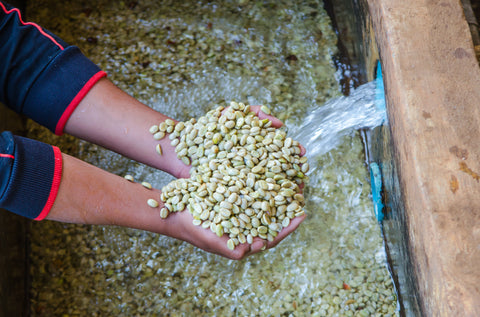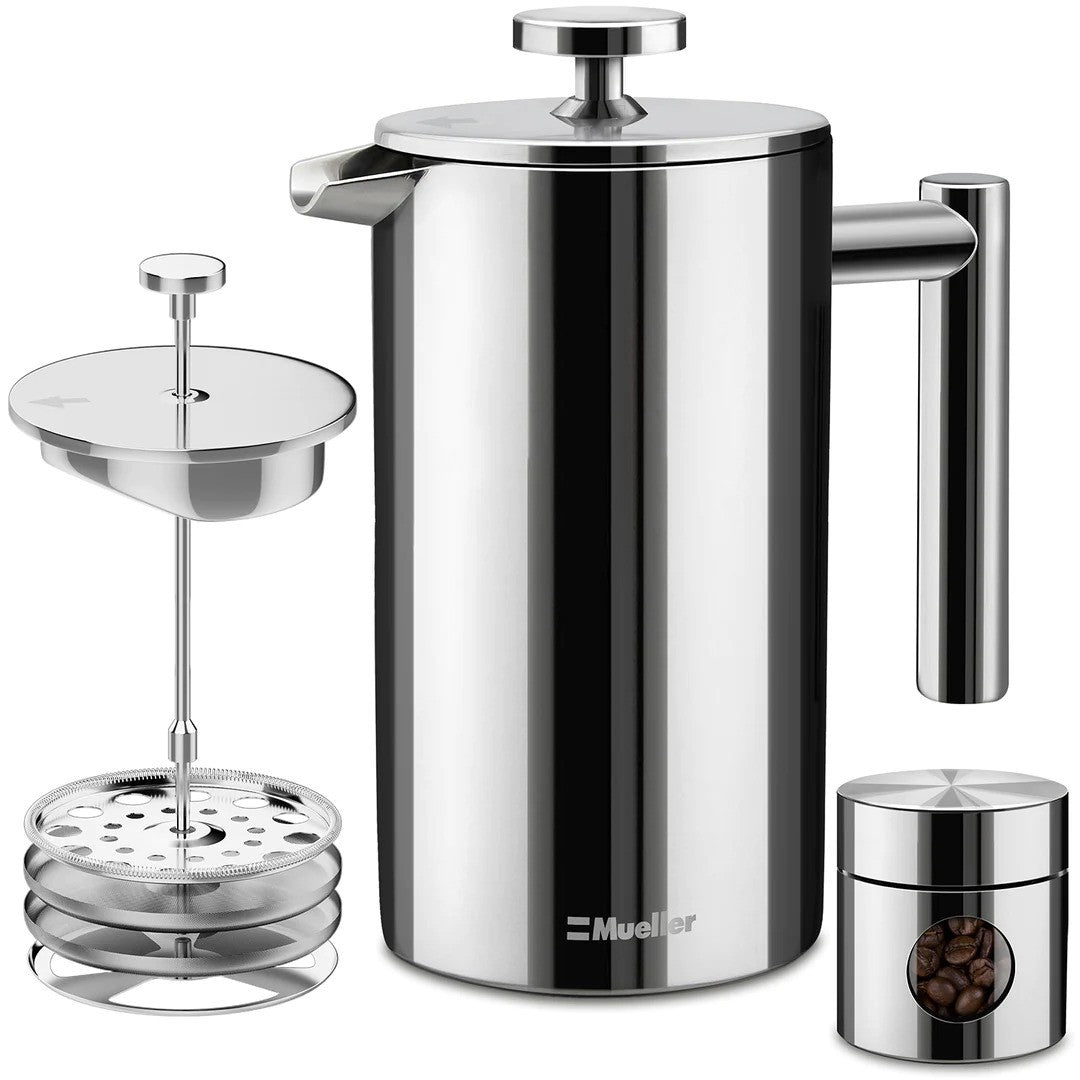Beer and Wine are Fermented - So is Coffee!
 After coffee fruit is picked, the farmer has to make decisions about how the coffee is processed. Coffee processing theory is filled with myth, ignorance and some science. Everyone has an opinion but there are few facts.
After coffee fruit is picked, the farmer has to make decisions about how the coffee is processed. Coffee processing theory is filled with myth, ignorance and some science. Everyone has an opinion but there are few facts.
With little scientific fact available, farmers are on their own. Coffee fruit processing tends to be regional and traditional, handed down from one farmer generation to the next. Coffee processing in East Africa is dramatically different than coffee processing in Central America. The result is that creating great coffee is more art than science, with a lot of luck thrown in.
In Hawaii, the traditional coffee processing method is to pulp the fruit, put the pulped beans in fresh water overnight, wash the beans off in the morning and put them out to dry. This usually results in incomplete removal of the mucilage layer around the bean. What the beans gain are sweetness and lower perceived acidity. What the beans lose are aroma, flavor and aftertaste. Some Hawaiian farmers are beginning to use new fermentation techniques to completely remove the mucilage and to enhance the aroma, flavor, and aftertaste.
Coffee fruit is composed of a number of layers: skin, pulp, mucilage, parchment, silverskin and finally the green bean. To create a green bean ready for roasting all of the outer layers have to be removed. The skin, fruit pulp, parchment and silverskin are all removed by machines.
The mucilage layer is an insoluble coating surrounding the coffee bean. Fermentation in water is the traditional method of removing this coating. (Wet processing) In this process, the material is made soluble through fermentation and then washed off, leaving a bean ready for drying.
Historically coffee research has focused on removing the insoluble coating from the bean quickly and cheaply.(Hoffman) One result has been mechanical demucilagers. It is only recently that researchers have focused on positive changes created by processing in brewed coffee aroma, acidity, flavor and aftertaste. (Lee)
In wet processing removing the layer surrounding the bean is given a number of names e.g. fermentation, maceration, and demucilage. There are critics of each of these terms. Fermentation is defined as a metabolic process where sugar is converted to alcohol, gas and acid. (White) Since this is one of the processes which occurs in wet coffee processing, it is an appropriate term.
Coffee fermentation is one area where there is a lot of chatter but little scientific fact. Opinion ranges from fermentation has no effect on coffee flavor (Giuliano) to fermentation improves the flavor of the bean (David).
The facts are:
- The mucilage surrounding the bean after pulping is composed of: pectin (33%), sugars (20%), reducing sugars (30%) cellulose and ash (17%).(Wrigley, 455).
- Putting the pulped beans in water creates a soup which contains among other things, organic acids, yeasts, enzymes, bacteria and microbiota. All of these materials are naturally occurring on or in the coffee fruit except for some bacteria which comes from the hands of the pickers. (Pereria II)
- The materials in the soup undergo a spontaneous fermentation, carried out by microbiological processes that involve the yeasts, bacteria and filamentous fungi. (Pereria I)
- The parchment and the silverskin surrounding the bean are porous. After removal of the insoluble coating, organic materials in the soup infuse into the bean. (Pereira II)
- The pH of the soup immediately after adding water is around 6.5. (slightly acidic).(ICO) (Jackels)
- Over time the pH of the soup begins to decline and, if left unchecked, can decrease to below 4. (very acidic) (Jackels)
- Enzymes react with the insoluble pectin around the bean creating water soluble compounds. (hydrolysis) (Pereira II)
- The enzymes are naturally occurring in the coffee fruit and bean and are created by bacteria living on the bean. (ICO)
- Pectin degrading enzymes are also produced by some strains of yeast. (Masoud)
- Naturally occurring yeasts and bacteria may also break down the mucilage around the bean. (Pereira II)
- The yeasts in the soup react with the naturally occurring sugars and on the sugars created by hydrolysis of the pectin.(Lee)
- Some of the sugars react with yeasts to create alcohols.(White)
- Some of the sugars infuse into the bean where they are caramelized during roasting. (Lee)
- As the yeasts, the enzymes and maybe the bacteria interact they also create organic acids, like chlorogenic, malic, acetic, citric, quinic, lactic, phosphoric and others. If these acids become predominate they will affect the flavor of the coffee. At low concentrations some of these acids have a positive effect on flavor e.g, citric (citrus fruit), phosphoric (brightness), and malic (apple). (Pereira II)
- Some of the acids combine with the alcohols in the soup to create esters. Simple esters have positive flavors that infuse the bean and improve the brewed coffee flavor. Some examples are ethyl acetate (anise, pineapple), isobutyl acetate (apple, banana), isoamyl acetate (banana, pear), and ethyl laurate (floral). (Pereira II )
- If fermentation is carried on too hot or too long, flavors are created in the bean that are described as fermenty and sour. (Jackels) These flavors may be the result of organic acids or other materials in the soup. There is no reliable scientific information about the cause of fermented and sour tasting coffee other than letting the beans get too hot or ferment too long.
- There is also no reliable scientific information on when the fermentation process should be stopped. In some countries farmers use a stick inserted into the fermentation tank to determine when to stop fermentation. (Mercer) Some literature suggests feeling the bean to see if it is still slippery (Bittenbender). Other suggestions are measuring the pH and stopping the process at 4.6. (Jackels) However, there is no clear correlation between these methods and the flavor of the roasted bean.
So there you have all of the facts that exist today. This is an emerging area of coffee science and new facts will be discovered. The future for farmers is adding yeasts, enzymes and bacteria to fermenting coffee to create different characteristics.
Bibliography
Bittenbender, Skip 2008 Growing Coffee in Hawaii University of Hawaii. (”The fermentation must be stopped as soon as the mucilage is completely broken down. This can be determined by a very simple test: wash a handful of the beans from the vat in clean water. If they are no longer slippery, the fermentation is complete.)
David, Ken Processing : Fruit Removal and Drying, Coffee Review (“…eliminating the fermentation step, the practice definitely robs mill operators of the most important expressive option they have at their disposal to influence coffee flavor” )
Giuliano, Peter A long overdue report on some coffee fermentation experiments. Pax Coffea. August 14, 2012 (“There is not (sic) conclusive evidence that fermentation adds much to coffee quality…”)
Hoffman, James Introduction to the chemistry of the wet process jimseven December 6, 2007 (The primary goal of the wet process is to remove the sticky layer of mucilage that surrounds the beans and parchment before the coffee is dried.“)
ICO, Good Hygiene Practices Along the Coffee Chain, Fermentation of Coffee – Control of Operation http://www.ico.org/projects/Good-Hygiene-Practices/cnt/cnt_en/sec_3/docs_3.3/fermentation.pdf
Jackels Susan C Characterization of the Coffee Mucilage Fermentation Process Using Chemical Indicators: A Field Study in Nicaragua Journal of Food Science 70(5):C321 – C325 · May 2005
Lee, Liang Coffee fermentation and flavor – An intricate and delicate relationship Food Chemistry Volume 185, 15 October 2015, Pages 182–191
Masoud, W. M. H., & Jespersen, L. (2006). Pectin degrading enzymes in yeast involved in fermentation of Coffee arabica in East Africa. International Journal of Food Microbiology, 110(3), 291-296. DOI: 10.1016/j.ijfoodmicro.2006.04.030
Mercer, Don Coffee: The Long Journey of a Little Bean ( “After about 24 hours or so, the progress of the fermentation is tested by inserting a long stick into the tank of fermenting coffee beans. Once the contents of the tank have thickened sufficiently that an indentation is left when the stick is removed, the fermentation is complete.”)
Pereria I Pereira, Gilberto et al, Isolation, selection and evaluation of yeasts for use in fermentation of coffee beans by the wet process International Journal of Food Microbiology 188C:60-66 · July 2014
Pereira II, Pereira,Gilberto et al Conducting starter culture-controlled fermentations of coffee beans during on-farm wet processing: Growth, metabolic analyses and sensorial effects Food Research International Volume 75, September 2015, Pages 348–356
White et al Yeast: 2010 The Practical Guide to Beer Fermentation Brewers Publications
Wrigley, Gordon. 1988. Coffee. New York: John Wiley and Sons.

